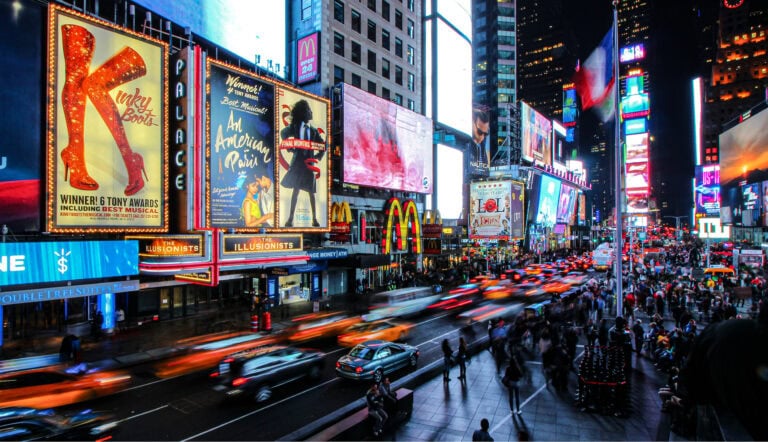What Is Location-based Targeting?
Location-based targeting, often executed through geofencing, allows advertisers to deliver contextually relevant advertisements to a hyper-targeted audience within specific geographic boundaries. Delivering timely, location-aware messages helps advertisers engage the right audience, reduce wasted impressions, and maximize return on investment. By leveraging location-based technology, retailers can capture attention, influence behavior, and track engagement. As a result, advertisers can refine promotional campaigns with insightful analytics on foot traffic, dwell time, and conversion rates.
DOOH Media Allows Advertisers to Guide the Purchase Journey
Digital out of home (DOOH) screens placed in stores, on busy sidewalks and along the road allow brands to display their message at the best time and place to influence consumer behavior. For instance, when a customer enters a shopping mall, a nearby DOOH screen can display tailored promotions based on the shopper’s location and guide the entire purchase journey.
The evolution from static to digital and programmatic out of home (OOH) media has unlocked powerful new capabilities in location-based targeting. Nearly 90% of digital marketers use location-based data in campaigns.1 By leveraging real-time data and geolocation, advertisers can now direct foot traffic in retail environments, highlight relevant offers, and even extend engagement to mobile devices. This creates seamless, end-to-end brand experiences.
Geofencing Reaches Hyper-Targeted Audiences
To effectively reach consumers in an increasingly digital economy, advertisers must leverage geofencing, a location-based technology that creates virtual boundaries around specific geographic areas. These geofences can be strategically placed around high-traffic areas, competitors’ stores, neighborhoods with favorable demographic characteristics or within the proximity of a DOOH advertising display. Geofences may be defined using predefined geographic areas, such as cities, zip codes or streets, or refined using foot traffic data to determine an advertiser’s trade area more accurately. Once the geofence is established, the digital advertisement campaign can be created and connected to the area.
When consumers enter the area, the IDs of their mobile devices are captured by GPS technologies allowing targeted ads to be sent. These ads can be in the form of banner notifications, in-app offers or text messages. Advertisers may also engage with a location-based service that dynamically updates DOOH content by incorporating real-time data on the weather, time of day or local events. Other actions may include sending targeted advertisements on social media platforms or websites.
Approximately 42% of mobile users have opted into location sharing, enabling advertisers to take advantage of the ability to deliver ads when they are most relevant.2 Geofencing boosts engagement rates by up to 30%, yields a click-through rate (CTR) of 4.39% (compared to 0.7% for standard DOOH displays) and increases conversion rates by up to 30%.2
Contextually Relevant DOOH Campaigns Are More Effective
Brain Response
A study monitored the brain response of 160 participants exposed to DOOH ads relevant in moment of delivery and content based on the location, weather or a live update. Brain response increased over 32% when displaying an ad relevant in time and content.3
Sales Effect
Sales increased by over 9% when using standard DOOH campaigns compared to those without OOH media presence.3 Sales increased by over 16% when using contextually relevant DOOH campaigns compared to those without OOH media presence.3
Customer Experience
59% of customers said that DOOH ads improve their shopping experience.4 56% of customers purchased an item featured in the DOOH screen.4
The Future of Geofencing
Globally, the geofencing market size is projected to grow from $1.5B in 2023 to $4.2B by 2028, reflecting a 22.9% CAGR.5 The market is expected to grow due to increased use of spatial data, advancements in real-time location technology, and higher adoption of location-based applications among consumers globally.
The rollout of 5G and AI-powered ad delivery will further enhance the precision and effectiveness of DOOH campaigns and geofencing. Ambient invisible intelligence, which is powered by AI, real-time data, advanced sensors, and analytics, can further transform geofencing.6 These technologies now fine-tune audiovisual environments while controlling spatial elements like lighting and climate, informing advertisers on how their campaigns can react to consumer behavior instantly. By incorporating these technologies, a geofenced DOOH campaign could potentially predict when consumers are likely to visit a retailer based on past behavior and deliver ads to reflect personalized promotions.
Geofenced DOOH screens allow advertisers to intimately engage with potential customers before, during and after a purchase journey. By leveraging location-based targeting, retailers can improve their understanding of customer behavior and adjust their marketing tactics to increase sales and capture more consumers.
Sources:
- Reveal Mobile. How Digital Marketers Use Location Data in Advertising
- Gitnux. Geofencing Statistics
- Clear Channel. Relevancy in Digital Out of Home
- Doohly. How DOOH Advertising Drives Shoppers at Every Stage of the Sales Funnel
- Grand View Research
- Solomon Partners. A/V Action Report June 2025



